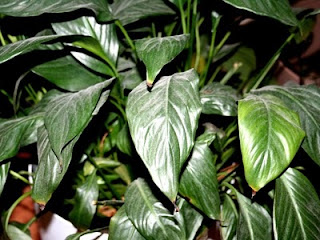 It's time for spring cleaning. Oh joy. Though not my favourite activity, it does offer a wonderful sense of satisfaction when it's completed. Fortunately for me, we just moved in to a new home so most of the major cleaning was done just a couple months ago. The plants, however, still carry the dust of 2009, with more layered on during the move. They missed getting their usual fall cleansing and are crying out for attention.
It's time for spring cleaning. Oh joy. Though not my favourite activity, it does offer a wonderful sense of satisfaction when it's completed. Fortunately for me, we just moved in to a new home so most of the major cleaning was done just a couple months ago. The plants, however, still carry the dust of 2009, with more layered on during the move. They missed getting their usual fall cleansing and are crying out for attention.Commercial plant soaps and leaf gloss can be expensive, though. Instead, I use a couple household products that cost fractions of cents per use. One is dish detergent and the other is glycerine.
First, I give water-loving plants a shower. Literally. I wait until they're fairly dry, ready for watering, and then place them in the tub. The water must be tepid, neither hot nor cold, and I ensure that temperature before opening the shower valve. Also, a gentle stream of water is best. Harsh spray will tear tender leaves and branches. Once the shower is started, I place one drop of dish soap on my palm and, under the shower stream, rub my hands together to create suds. These suds rain down on the plant and should be allowed to penetrate the soil. Depending on the size of the plant, you might need to repeat this sudsing a couple times. This has a three-fold effect: it cleans the leaves and branches; it helps kill aphids, spider mites and their eggs; and, it provides some mild fertilization.
Not all plants tolerate a shower. My Cycad or African violet would die miserable deaths if watered so profusely and directly. For these plants, I use an old (but clean) make-up brush to remove lint and dust. If there are stubborn deposits, I use a soft terry-cloth rag to wipe soil from firm leaves, those without hairs as this process would damage them.
Once the plants have all been cleaned, I apply a home-made leaf polish. To make your own, combine ½ teaspoon glycerine with ¼ cup tepid water. Stir until glycerine is well dissolved. Then, dip a soft (rag) cloth in the mixture, wring it out until just damp, and wipe leaves gently. The result will be a cl
This whole process may take days, depending on the number of plants queuing for the shower and leaves awaiting individual attention. After plants are cleaned, they perk up noticeably. Quite often, new leaves and branches sprout eagerly after I've completed this twice-yearly procedure. Dust clogs the pores but, once clean, plants "breathe" easier, prompting their growth and increasing their capacity to filter household pollutants from the air.
No comments:
Post a Comment
I welcome your comments, questions, and/or suggestions. Please keep your posts respectful of others and your language appropriate for all ages. Thank you!